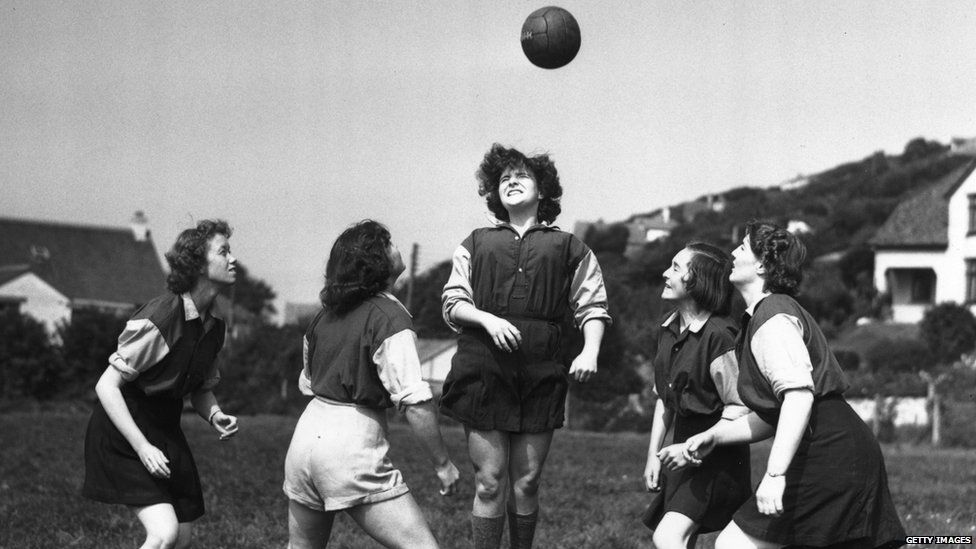Women's World Cup 2023: When women's football thrived decades ago
- Published

Millions of people will be tuning in to see England take on Spain in the Women's World Cup final.
The tournament in Australia and New Zealand has so far seen more than 1.7 million tickets sold and has been the highest-profile women's football competition yet.
It's the latest peak in a growing interest in the women's game, which has been building up over the last few years - after decades in the shadow of men's football.
But it wasn't always like that - at one time, the sport flourished in England.
Matches pulled in huge crowds - sometimes more than 50,000 people.
But then the women's game was effectively banned, with the FA at the time saying the game of football was "quite unsuitable for females".
It was another half century until women's football got back on its feet - and that's one reason it lags behind the men's game today.
This woman was the Lauren Hemp of her day
Lily Parr was a winger and one of the first female professional players.
She played for the Dick, Kerr's Ladies team which got its name from the munitions factory in Preston where most of the team worked during World War One.
They were the first women's team to play wearing shorts, and the first to go on an overseas tour.
Lily was also a smoker, which led to rumours her wages were supplemented by packets of Woodbine cigarettes.
In 2002, she became the first woman to be inducted into the National Football Museum Hall of Fame - and she recently became the first female footballer to be commemorated with a statue.
Women's matches pulled in enormous crowds
There was a huge growth in women's football during the war when women were called upon to do factory jobs left by the men who had gone to fight.
On Christmas Day in 1917, 10,000 spectators watched two women's teams playing at Preston.
And when Dick, Kerr's Ladies played St Helen's Ladies on Boxing Day 1920 they pulled in a crowd of 53,000 at Everton's Goodison Park ground, with thousands more fans locked outside.
But then the women's game was effectively banned
On 5 December 1921, the Football Association banned women from playing on FA-affiliated pitches which meant stars like Lily Parr could no longer play at grounds with spectator facilities.
The FA at the time said "the game of football is quite unsuitable for females and ought not to be encouraged".
In 1971 the ban was finally lifted following the formation of the Women's Football Association (WFA) a couple of years earlier.
Finally women could treat football as a career, 50 years later
The Sex Discrimination Act of 1975 made it easier for women to train to become professional referees.
A profile of Joan Briggs, "celebrated star of the ladies' soccer world".
It has always been pretty tough to watch women's football on television with the first TV reports of the Women's FA Cup final results in the 1970s.
In 1989 Channel 4 started to provide regular coverage of women's football.
And the FA outlined its plans to develop the women's game from grassroots to elite level in 1997.
It was only in 2018 that the Women's Super League (WSL) became fully professional.
Now, the latest figures show 3.4 million women and girls play football in England.
The Euro 2022 final drew a record crowd of 87,192 at Wembley, where England beat Germany to win their first major women's tournament.
There has since been growing investment, meaning better salaries and longer contracts for women.
When it comes to those watching on TV in the UK, England's World Cup semi-final against Australia was the most watched of the tournament so far, with a peak audience of 7.3 million.
A version of this article was published in 2019.
How to watch the Women's World Cup final
The Women's World Cup final between England and Spain on Sunday will be shown live on BBC One, BBC iPlayer and the BBC Sport website from 09:45 BST.
BBC Radio 5 Live and BBC Sounds will have radio commentary as both sides aim to win their first World Cup.
The BBC Sport website and app will provide live text commentary from 08:00 BST.
- Published1 August 2022
- Published5 days ago
- Published21 July